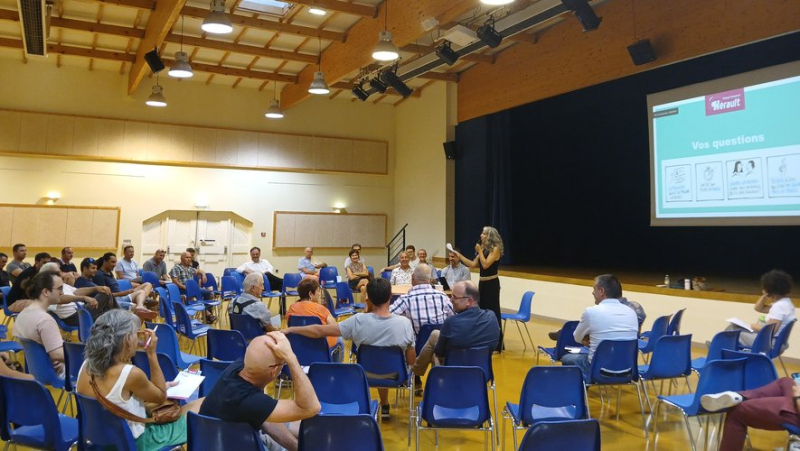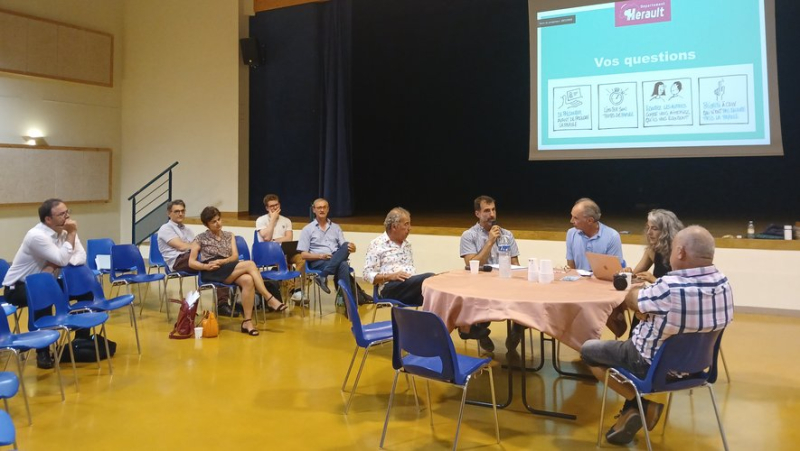If the need for water is unanimous, the location of winter reservoirs divides

Conference on the feasibility study of winter reservoirs, Bosquet de Florensac room Gaelle Liot

Divers acteurs (agriculteurs, associations, viticulteurs…) débattent sur les retenues hivernales, autour d’une table ronde. Gaelle Liot
L’unanimité n’était pas totalement au rendez-vous, lors de la réunion publique, sur les retenues hivernales (réserves d’eau), ce jeudi 11 juillet, à Florensac. En effet, cette réserve d’eau devrait impacter le domaine de Picpoul de Pinet.
Around the table, farmers, wine growers, associations, actors from the associative, research and institutional world debated, this Thursday, July 11, on the departmental project to study the feasibility of winter reservoirs, in the room du Bosquet, in Florensac. It was hot and heavy, but there were many who made the trip.
From 4 to 15 ha, there are seven of these winter reservoirs planned in three territories. Each sector reported a very significant lack of water. The first includes the municipalities of Caussiniojouls, Autignac, Magalas (1.1 million m3 of water), the second Pouzolles and Coulobres (1.1 million m3 of water) and the last, Florensac (1.2 million m3 of water). All are located near the Rhône (Aqua Domitia).
"The debates at the meetings that we organize mainly focus on the quality and flow of the Rhône water which will exclusively fill these reservoirs in winter. But also on the landscape modifications linked to their implementation", confides Myriam Tancogne, project manager at the Hérault prefecture office.
In the assembly, if everyone agreed on the need to see a water point, installed near their crops. There was no unanimity on its location. Indeed, the Picpoul de Pinet estate risks seeing its terroir partly impacted.
19 ha of uprooted vines… in the heart of production
"NoWe are divided, we are in dire need of water, but this reserve risks being reduced to our land of 19 ha. Which means uprooting vines that we cannot plant elsewhere and which are in the heart of production", worries Céleste Renault, communications manager for the union of the AOP Picpoul de Pinet. To add: "We have already been impacted by the motorway and the passage of the TGV. We have an appellation that works very well, and we risk losing, in total, nearly 10% of our 1500 ha. On the other hand, the landscape of our vines will be impacted, even if we obtain financial compensation. Finally, we already have to deal with growing demand and we don't have enough stock to sell".
This water resource will be accessible to farmers (85% of the people concerned are winegrowers), municipalities, firefighters and local wildlife thanks to an additional development for game and birds. Each user will have a connected meter, allowing them to monitor the quantity of water used in real time, their billing and their authorized quota.
At this stage, the current study aims for a theoretical investment of 20 million euros for five deductions. These projects represent less than 10% of the budget allocated by the FEADER, the Region and the EPCI, to respond to the climate challenge over the period 2018-2030, in the part of the Hérault irrigation scheme. It is planned to create local union associations to manage the plots. Ultimately, the project owner of these winter reservoirs will be the local community which will assume the initial investment, its management and its long-term safety.
What water capacity is available via these winter reservoirs ?
The Rhône pours 55 billion m3 every year into the world. the sea. BRL (development company of Bas-Rhône and Languedoc) has a withdrawal authorization of 150 million of m3 to supply its network. In winter, the water transport potential by Aqua Domitia is not used. that’à 15%. The total withdrawal envisaged as part of this feasibility study would be 0.5 m3/s in winter, for a flow rate of the Rhône greater than 1 250 m3/s. A recent study by the Rhône Mediterranean Corsica Water Agency (2022) on the impacts of climate change shows that flow of the Rhône will be maintained and increased in winter (approximately 1.55 m3/s)."No sampling will take place in the groundwater< /em>", assured the Department.




